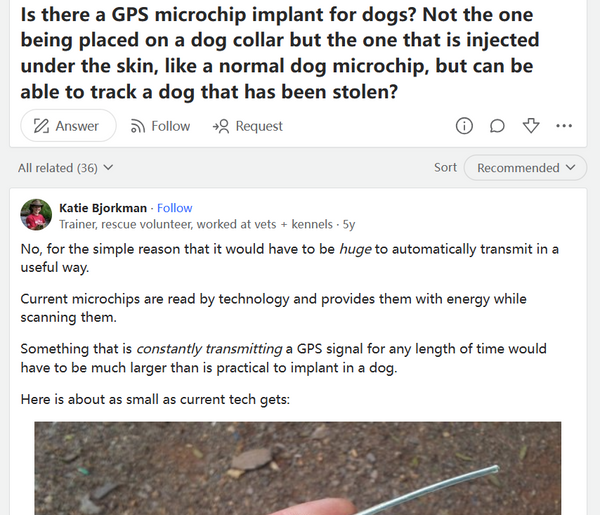The Reality of GPS Chips for Dogs: Real or Fake?
In modern society, pets have become important members of many families. With the continuous advancement of technology, people's concern for pet safety is also increasing. People widely use GPS technology as an advanced positioning system in pet trackers. It helps pet owners know where their beloved pets are in real-time.
But is there an implantable GPS chip for dogs? My answer is: no.
There is no such implantable GPS chip for dogs produced in the market. It is not healthy for your dog's body. Read this article to learn more about implantable GPS chips for dogs and other GPS pet trackers.
Table of Contents
1.GPS chips for dogs: implantable doesn't exist
GPS technology is widely used in the pet industry. Many pet owners want to know if it is possible to implant a GPS chip into their dog's body. This would make it easier for them to view their dog's location. And they don't have to worry about dropping the pet tracker they are wearing and so on.
However implantable GPS chips for dogs are not a good choice for dogs. Although such chips are not currently available, there are a lot of people searching for them regularly. You can also see pet owners asking about these chips on Quora.


While it may seem like this type of chip has a lot of advantages, it doesn't. It has many disadvantages for dogs.
1.1 Size
An RFID-enabled implantable chip without tracking is available on the market. It can be implanted in your pet's body. It doesn't contain GPS technology and is about the size of a grain of rice. GPS technology is used not only in the pet industry but also in the daily lives of humans.
GPS technology must be assembled with hardware. Even the smallest GPS device can't be the size of a microchip for dogs. The hardware of GPS technology is mainly composed of the following parts:
GPS module: this is the core part of the tracker and is responsible for receiving signals from satellites and calculating the exact location of the device.
Microcontroller: This is used to process the data provided by the GPS module and execute the code written in software to manage the functions of the tracker.
Mobile communication modules: such as LTE or GSM modules, are used to send location data to a cloud server or directly to the user's cell phone.
Power Management: Includes the battery and power management ICs that ensure the tracker has sufficient power and manages power consumption efficiently.
Antennas: Both GPS and mobile communication modules require antennas to receive and send signals.
The smallest GPS tracker in the world is larger than a microchip for dogs. This type of GPS tracker cannot be implanted into the body for use.

Beyond that, batteries are necessary to use the GPS. With the addition of a battery, the size of the dog GPS chip will be larger. And how to charge the battery will be a big problem.
So, implanting a dog GPS microchip into your dog's body will be very painful and uncomfortable for your dog. And it is not a safe behavior. It may affect the dog's physical health.
1.2Battery and Charging
General GPS trackers need to be charged. But how to charge an implantable GPS chip for dogs? Install a USB port on the dog's body. Or take it out of the dog's body when charging and finally install it back into the dog's body?
The above methods are impossible. That's why it's not practical to use this type of GPS chip for dogs. You don't have a way to charge it when its battery runs out. Repeatedly removing and installing it will also only harm the dog's body.
On top of that, implanting lithium-ion batteries in your dog's body poses a health risk. Lithium-ion batteries contain chemicals, such as cobalt and other heavy metals, as well as electrolytes and organic solvents.
If leaked, they can lead to chemical burns, tissue necrosis, and even more serious health problems.
1.3 Maintenance issues
When an implantable dog GPS chip is damaged, pet owners need to take their dogs to the hospital to have it removed. It is re-implanted into the dog's body after repair.
This is a difficult problem to solve just like charging a battery. Repeated implantation and removal will only cause harm to the dog's body. This is why these types of GPS chips for dogs are not recommended.
2.Microchips for dogs with RFID technology
A microchip with RFID technology was mentioned in the story about implantable GPS chips for dogs. A microchip with RFID technology is a small electronic chip encapsulated in a glass cylinder and resembles a grain of rice. The microchip has no battery and is activated by radio waves from a scanner.
The microchip with RFID technology is not a GPS device, and it cannot track the pet. After a pet is lost, someone needs to drop the pet off to be scanned for a microchip before they can access the information registered to the pet and owner.
So don't forget to register your pet's microchip after it is implanted. And update your contact information at the registry in time.
Advantages of this microchip with RFID technology:
| 1.Implanted in the pet's body, it will not be lost.
2.No need to charge. |
Disadvantages:
| 1.Cannot track your pet in real-time.
2.When the pet is lost, someone must pick up the pet and bring it to be scanned for the microchip before the owner can retrieve the pet. 3.Pet owner has to update the information in time. |
3. Aorkuler pet tracker
If you think microchip with RFID technology is not a solution for your pet's safety, there is a GPS pet tracker available.
The Aorkuler pet tracker is a device that is worn on the pet's body. It is compact and will not burden your pet's daily life. It is made up of GPS and radio technology. After GPS localization, the location information is transmitted to the controller via radio technology.
In contrast to implantation in the pet, Aorkuler pet tracker can reduce the pain of the pet. It does not require the use of a cellular network and has no monthly subscription fee. And it can be used in remote areas.
The Aorkuler pet tracker also tracks pets in real-time. The owner can check the pet's location information on the controller at any time. Even if the pet is lost, the owner can quickly find the pet according to the tracker.
In addition, the Aorkuler pet tracker has sound and flash functions. Owners can quickly find their pets in the neighborhood with these two functions.
Compared with microchips, the Aorkuler pet tracker does not require strangers to bring their pets to scan the chip to get the owner's information. It also doesn't require the pet owner to update the information frequently.
4.To summarize
Implantable GPS chips for dogs don't exist. Implanting larger objects into your dog's body can cause them difficulty. And it can have an impact on your dog's health.
In addition to that, microchips can't track the locati0n of your pet. It's troublesome to find the pet when it's lost.
All in all, the Aorkuler pet tracker is a good choice. It doesn't need to be implanted in the dog's body but also can track the pet in real-time. For the safety of pets, pet owners can purchase an Aorkuler pet tracker. This is not only responsible for the pet but also reduces the trouble for the owner.

